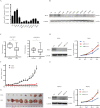BCL6-SPECC1L: A Novel Fusion Gene in Nasopharyngeal Carcinoma
- PMID: 36412101
- PMCID: PMC9706053
- DOI: 10.1177/15330338221139981
BCL6-SPECC1L: A Novel Fusion Gene in Nasopharyngeal Carcinoma
Abstract
Background: Nasopharyngeal carcinomas (NPCs) are malignant tumors originating from the lining epithelium of the nasopharynx. Fusion genes have been confirmed to play important roles in the occurrence and development of various malignant tumors, but the role of fusion genes in NPC is poorly understood. We aimed to explore new fusion genes that promote the occurrence and development of NPC. Methods: RNA-seq was used to search for interchromosomal translocations in 18 NPC tissues. Polymerase chain reaction (PCR) and Sanger sequencing were applied to verify the presence of BCL6-SPECC1L (BS); quantitative PCR (qPCR) and Western blotting were used to measure the expression level of BCL-6 in NPC cells; MTT and in vivo tumorigenesis assays were applied to evaluate the cell proliferation ability; immunofluorescence assays were used to determine the cellular localization of BCL6 and BS; and a luciferase reporter assay was performed to evaluate the ability of BCL6 and BS to inhibit transcription. Results: BS was present in 5.34% (11/206) of primary NPC biopsies and 2.13% (1/47) of head and neck cancer biopsies. The expression of BCL6 was downregulated in NPC, and silencing of endogenous BCL6 promoted NPC cell proliferation in vitro. Overexpression of BCL6 but not BS inhibited the growth of NPC cells in vivo and in vitro. Mechanistically, BCL6 localized in the nucleus can inhibit the G1/S transition to suppress the growth of NPC cells. However, after the fusion of BCL6 and SPECC1L, the product cannot localize to the nucleus, and the transcriptional inhibitory function of BCL6 is abolished, eventually abolishing its tumor suppressor effect and leading to the development of NPC. Conclusion: BS is a novel fusion gene in NPC that may play an important role in the occurrence and development of this cancer. The clinical significance of the BS fusion gene needs further elucidation.
Keywords: BCL6; RNA-seq; SPECC1L; fusion gene; nasopharyngeal carcinoma.
Conflict of interest statement
The authors declared no potential conflicts of interest with respect to the research, authorship, and/or publication of this article.
Figures




References
-
- Chen YP, Chan ATC, Le QT, Blanchard P, Sun Y, Ma J. Nasopharyngeal carcinoma. Lancet. 2019;394(10192):64‐80. - PubMed
-
- Hanahan D, Weinberg RA. Hallmarks of cancer: The next generation. Cell. 2011;144(5):646‐674. - PubMed
-
- Edwards PA. Fusion genes and chromosome translocations in the common epithelial cancers. J Pathol. 2010;220(2):244‐254. - PubMed
-
- Saramäki OR, Harjula AE, Martikainen PM, Vessella RL, Tammela TL, Visakorpi T. TMPRSS2:ERG Fusion identifies a subgroup of prostate cancers with a favorable prognosis. Clin Cancer Res. 2008;14(11):3395‐3400. - PubMed
Publication types
MeSH terms
Substances
LinkOut - more resources
Full Text Sources
Molecular Biology Databases

